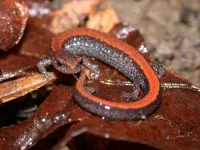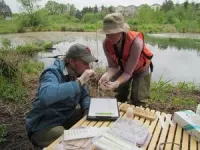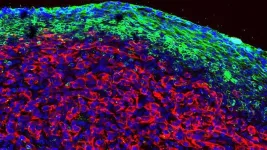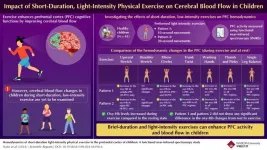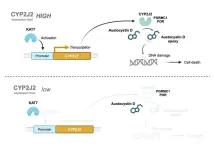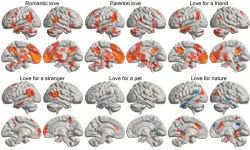(Press-News.org) RESTON, Va. — Two recent amphibian-focused studies shed light on the ecological importance of red-backed salamanders, while confirming that proactive measures would prevent costly impacts from a wildlife disease spreading across Europe that has not yet reached North America.
Scientists knew that red-backed salamanders were abundant in eastern North America, but a recent study found their densities and biomass across the region were much higher than expected. The study authors estimated an average of 5,300 salamanders in every patch of forest the size of a football field in the Northeast. Even though each individual is a mere 3 inches long, the sheer number of red-backed salamanders means that they also have some of the highest biomass estimated for animals other than insects in the Northeast, similar to or greater than white-tailed deer.
The study, “Range-wide Salamander Densities Reveal a Key Component of Terrestrial Vertebrate Biomass in Eastern North American Forests,” conducted by U.S. Geological Survey and many partner institutions, was the first time that the densities and biomass for this common, but rarely seen, species were calculated across the extent of its range.
The incredible magnitude of red-backed salamander presence in the Northeast captured in this study suggests that red-backed salamanders, and likely amphibians in general, play a more prevalent role in terrestrial temperate ecosystems than previously suspected.
“The very large biomass of red-backed salamanders tells us that they are likely ‘small but mighty’ in terms of their role in the ecological health of northeastern forests,” said Evan Grant, lead author and USGS research wildlife biologist. “If red-backed salamanders disappeared, there would probably be some pretty large ecosystem-level consequences.”
Many salamanders, like the red-backed salamander, are tiny and spend the majority of their time underground, so it’s easy for most people to overlook them. In fact, Grant commonly refers to salamanders and other amphibians as “hidden biodiversity” because, though they are often abundant, they hide well. But that doesn’t mean people should overlook their ecological roles. Salamanders eat things that bigger consumers can’t eat and are themselves prey for other animals, meaning salamanders punch above their weight in an ecosystem’s food web.
“Salamanders serve a vital function in forest ecosystems,” explained David Miller, professor of wildlife ecology at Penn State and co-author of the study. “They are at the top of the food chain on the forest floor, where everything is breaking down into the soil that sustains this entire network of life. In fact, salamanders are so important to this life cycle that we can use them as a barometer for forest health.”
Unfortunately, just as scientists are beginning to understand the true magnitude of salamanders’ ‘hidden biodiversity’ and ecological importance, a new wildlife disease that is particularly hard on salamanders is a looming threat and a serious concern for scientists and wildlife managers.
Batrachochytrium salamandrivorans, or Bsal for short, is a fungal disease closely related to the chytrid fungus that is already devastating amphibian populations around the world. It was first found in the Netherlands in 2013. Sadly, since its introduction, Bsal has decimated the salamander populations in central Europe and continues to spread across Europe.
Bsal hasn’t been detected in the U.S. yet, so scientists and wildlife managers are preparing for its arrival. There is a North American Bsal Task Force whose mission is to limit the invasion and reduce the impact of Bsal in North America. However, natural resource managers ran into a problem when trying to enact proactive management guidance for a disease that isn’t even on U.S. shores yet.
They needed evidence that proactive management would be more effective than waiting to respond until the disease is detected in the wild. So, Grant co-authored another recent paper that tested a series of proactive and reactive management actions to forecast the impact on salamander populations over time.
This study, “Proactive management outperforms reactive actions for wildlife disease control,” used computer modeling to confirm what seems intuitively obvious: namely, initiating management of wild populations before Bsal arrives is, in fact, more successful at achieving the management goal of keeping salamanders from disappearing than waiting until after Bsal is detected or not doing anything at all.
“If we do nothing to manage Bsal, the model forecasted that the disease would be catastrophic to North American salamander species,” said Molly Bletz, assistant professor of disease ecology at Penn State and lead author of the second study. “This study gives strong quantitative support to proactive management actions. Basically, if we want these at-risk salamander species to be around in the future, doing something proactively is our best bet.”
The types of proactive management actions considered included:
making it harder for amphibians to spread the disease amongst themselves through installing barriers or increasing habitat complexity;
reducing Bsal fungal spores in aquatic habitats by temporarily raising the water temperatures, increasing the salinity, or increasing the abundance of zooplankton that consume funguses;
helping amphibians fight off the disease by improving their health through supplemental feeding, etc., increasing the abundance of local, beneficial anti-fungal microbes, or through vaccination.
While this second study did not estimate how proactive management for Bsal may affect other parts of the ecosystem, visitor satisfaction or financial cost, Bletz, Grant and others are already working on estimating these outcomes so that managers have a full accounting of the relative benefit of proactive versus reactive management.
“With a new understanding of how incredibly prevalent salamanders are in an ecosystem, and with the empirical justification for the benefits of proactive management for salamander populations threatened by Bsal, it is more critical than ever to protect the ‘hidden biodiversity’ of amphibians,” said Bletz.
END
Study finds salamanders are surprisingly abundant in northeastern forests
This news comes as scientists assess potential costs of a looming amphibian disease before it arrives on US shores
2024-08-26
ELSE PRESS RELEASES FROM THIS DATE:
Old chemo drug, new pancreatic cancer therapy?
2024-08-26
The fight against cancer is an arms race, and one of the most effective weapons in clinicians’ arsenals is immunotherapy. Immune checkpoint therapy has become the standard for treating several types of cancer. However, the Nobel Prize-winning strategy is ineffective for most pancreatic ductal adenocarcinoma (PDAC) patients.
“Immune checkpoint therapy is only an option in rare cases of PDAC,” Cold Spring Harbor Laboratory (CSHL) Professor Douglas Fearon says. “It’s only effective for patients with a specific subtype of PDAC—that’s less than 5% of all cases.”
Until recently, it was thought that PDAC didn’t ...
Shakespeare in sign language, seen through AI
2024-08-26
A new study uses co-creation with reference communities to develop an app for sign language machine translation (SLMT). The research team designed a theatrical performance in sign language, seen through the eyes of artificial intelligence (AI), as one of the methodologies. “Historically, deaf people have been excluded from the development of automatic translation technologies,” says Shaun O’Boyle, Research Fellow in the School of Inclusive and Special Education (Dublin City University DCU). “This has often caused backlash and resistance from deaf communities, as the projects were designed and ...
PLOS and the University of South Carolina announce APC-free Open Access publishing agreement
2024-08-26
SAN FRANCISCO — The University of South Carolina and the Public Library of Science (PLOS) today announced a three-year Open Access agreement that allows researchers to publish in PLOS journals[1] without incurring article processing charges (APC). This partnership brings together two organizations that believe researchers should be able to access content freely and make their work available publicly, regardless of their access to funds.
“The evidence is undeniable — open research enables the convergence of ...
Why children can’t pay attention to the task at hand
2024-08-26
COLUMBUS, Ohio – Scientists have learned that children find it hard to focus on a task, and often take in information that won’t help them complete their assignment. But the question is, why?
In a new study, researchers found that this “distributed attention” wasn’t because children’s brains weren’t mature enough to understand the task or pay attention, and it wasn’t because they were easily distracted and lacked the control to focus.
It now appears that kids distribute their attention broadly either out of simple curiosity or because their working memory isn’t developed enough to complete a task without “over ...
Short-duration, light-intensity exercises improve cerebral blood flow in children
2024-08-26
Cognitive functions, also known as intellectual functions, encompass thinking, understanding, memory, language, computation, and judgment, and are performed in the cerebrum. The prefrontal cortex (PFC), located in the frontal lobe of the cerebral cortex, handles these functions. Studies have shown that exercise improves cognitive function through mechanisms such as enhanced cerebral blood flow, structural changes in the brain, and promotion of neurogenesis. However, 81% of children globally do not engage in enough physical activity, leading to high levels of sedentary behavior and insufficient exercise. This lack of physical ...
Exploring the role of cytochrome oxygenases in augmenting austocystin D-mediated cytotoxicity
2024-08-26
Austocystin D, a natural compound produced by fungi, has been recognized for its cytotoxic effects and anticancer activity in various cell types. It exhibits potent activity even in cells that express proteins associated with multidrug resistance, attracting significant global research interest. Austocystin D promotes cell death by damaging their DNA, a process which might be dependent on cytochrome P450 (CYP) oxygenase enzymes. Notably, austocystin D has shown significant activity against cancer cells with increased CYP expression. However, the specific role and function of the CYP2J2 enzyme in the cytotoxicity of austocystin D remain ...
Knowing you have a brain aneurysm may raise anxiety risk, other mental health conditions
2024-08-26
Research Highlights:
People diagnosed with unruptured cerebral aneurysms (weakened areas in brain blood vessels) who are being monitored without treatment have a higher risk of developing mental illness compared to those who have not been diagnosed with a cerebral aneurysm. The largest impact was among adults younger than age 40.
The study conducted in South Korea found that the psychological burden caused by the diagnosis of an unruptured aneurysm may contribute to the development of mental health conditions, such as anxiety, stress, depression, eating ...
Non-cognitive skills: the hidden key to academic success
2024-08-26
A new Nature Human Behaviour study, jointly led by Dr Margherita Malanchini at Queen Mary University of London and Dr Andrea Allegrini at University College London, has revealed that non-cognitive skills, such as motivation and self-regulation, are as important as intelligence in determining academic success. These skills become increasingly influential throughout a child's education, with genetic factors playing a significant role. The research, conducted in collaboration with an international team of experts, suggests that fostering non-cognitive skills alongside cognitive abilities could significantly improve educational ...
Finding love: Study reveals where love lives in the brain
2024-08-26
We use the word ‘love’ in a bewildering range of contexts — from sexual adoration to parental love or the love of nature. Now, more comprehensive imaging of the brain may shed light on why we use the same word for such a diverse collection of human experiences.
‘You see your newborn child for the first time. The baby is soft, healthy and hearty — your life’s greatest wonder. You feel love for the little one.’
The above statement was one of many simple scenarios presented to fifty-five parents, self-described as being in a loving relationship. Researchers from Aalto University utilised ...
Researchers develop high-entropy non-covalent cyclic peptide glass
2024-08-26
Researchers from the Institute of Process Engineering (IPE) of the Chinese Academy of Sciences have developed a sustainable, biodegradable, biorecyclable material: high-entropy non-covalent cyclic peptide (HECP) glass. This innovative glass features enhanced crystallization-resistance, improved mechanical properties, and increased enzyme tolerance, laying the foundation for its application in pharmaceutical formulations and smart functional materials. This study was published in Nature Nanotechnology on ...
LAST 30 PRESS RELEASES:
New mega-analysis reveals why memory declines with age
Understanding ammonia energy’s tradeoffs around the world
UTHealth Houston researchers map gene disruptions in sporadic early onset Alzheimer’s disease across key brain regions
Minimum wage increases are linked to safer pregnancies
Left in the cold: Study finds most renters shut out of energy-saving upgrades
This crystal sings back: Illinois collaboration sheds light on magnetochiral instability
Organisms in the Atacama Desert soil are remarkably diverse
Children’s Hospital Colorado research outlines first pediatric classifications for suicide risk in adolescents and kids
No thyme wasted: Harnessing the medicinal benefits of thyme extract With small doses
Fat surrounding the colon interacts with the immune system
Genetic predisposition to excess body weight and survival in women diagnosed with breast cancer
New mechanism links Epstein-Barr virus to MS
Genetic risk factor and viral infection jointly contribute to MS
When a virus releases the immune brake: New evidence on the onset of multiple sclerosis
Wyss Institute-led collaboration awarded by ARPA-H PRINT program to engineer off-the-shelf, universal, transplant-ready graft for liver failure
Research on the behavioral mechanisms of rural distributed photovoltaic development: A view of prosumer perspective
More surgical patients are on opioid use disorder medications — hospitals must modernize pain care
New study reveals strategic logic behind global patent litigation venue selection
An abnormally slow heart rate is associated with xylazine-fentanyl overdose; primarily seen in northeastern United States
The path to solar weather forecasts
Inflammation and mitochondrial dysfunction in cirrhotic cardiomyopathy: therapeutic implications
The Great Bear Rainforest nature writing retreat
Research reveals hidden diversity of E. coli driving diabetic foot infections
Breakthrough in parallel Cartesian grid generation: Dynamic partition weight strategy resolves load imbalance
ESMT Berlin study shows how startups can communicate to win over silent audiences online
Design and optimization of wide-speed double swept waverider based on curved-cone projection method
Giant Magellan Telescope names Daniel T. Jaffe as president
New parameterization method for cislunar space cataloging enhances orbital awareness in Earth-Moon system
A “nu” way to measure researcher impact
Dark matter may have begun much hotter than scientists thought
[Press-News.org] Study finds salamanders are surprisingly abundant in northeastern forestsThis news comes as scientists assess potential costs of a looming amphibian disease before it arrives on US shores
